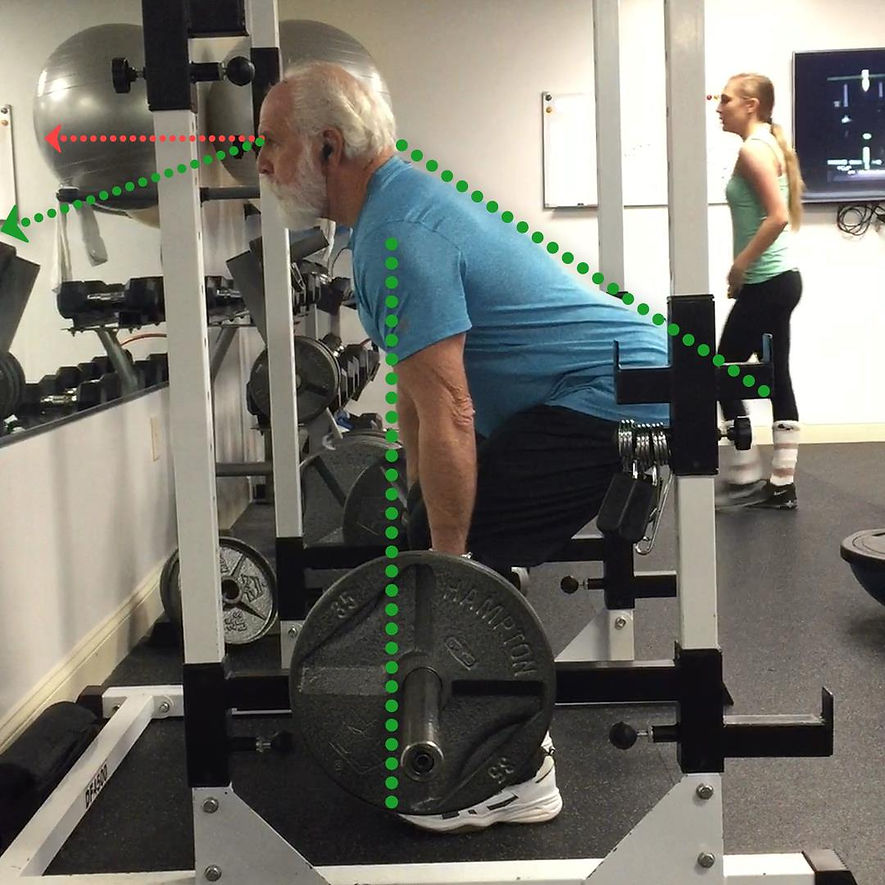
-
Strength & Conditioning
-
Post Physical Therapy
-
Technique Assessment
-
Introduction to weights
-
Injury Prevention
Posted January 10th, 2018 - Frankie Vincent

Squats and Dead-lifts, what is the difference...
Barbell exercises simply put can help improve one's life. From professional athlete to sedentary adult, all will benefit from proper barbell exercises. Performed properly adding basic lifts such as squats and dead-lifts, can enhance sports performance, improve one's mobility, and promote fat-loss, to name a few.
Tips on Squatting
-
Flat feet
-
Thoracic and lumbar spine held in extension
-
Vertical bar path over mid-foot
-
Hip drive out of bottom
Stance: Notes on stance
-
Feet shoulder width apart and toes pointed approximately 15 - 30 degrees out (neutral stance).
-
Our knees should be in-line with our feet. (Push knees out).

Keeping a neutral spine and weight through mid-foot.
-
Head and chest point in same direction, looking approximately 6-8 feet ahead. (Don't look up!)
-
Maintain a rigid spine.
-
Hips and knees bend simultaneously.
-Mehdi, 2018 (Like them on Facebook)
"When completing these barbell movements, technique should always be your top priority. Performing these exercises incorrectly inhibits your results." - COLLIN WHITNEY, "Importance of Barbell Training" - @WhitneyStrength
Katie Wheeler (video below) shows a bar path that goes forward, taking the weight away from mid-foot. With a few cues (sit back, push knees out e.g.) we can get back to our mid-foot. Keeping a vertical bar path is always the most efficient way to squat.
Frankie knows the training, and geniunely cares for the health and well being of his team and clients. Physical benefits obvious, but the mental clarity the real advantage. I'm a believer. - Ross Twiddy, CEO Twiddy & CO (see below)



Find a broomstick or the like (PVC pipe, curtain rod E.G.) and a raised seat and practice applying the above principles.

Pushing the knees out while simultaneously sitting hips back, eyes forward (not up), and maintaining a controlled descend all help keep our spine rigid.

"It would be very difficult to invent a more natural exercise for the body than picking up a progressively heavier barbell". -Mark Rippetoe (@mark.rippetoe.7)

1. "Rigid body" - where the shape and dimensions of our body are considered to be constant regardless of any forces applied – maintaining a “rigid body” is crucial in complex movements such as dead-lifts, squats, snatches E.G.
2. The bar path of a dead-lift travels up the shins and thigh in a vertical path over the middle of our feet. Our shoulders should stay just over the bar until the top of the lift.
Dead-lifting Tips:
-
Vertical barbell path.
-
Keep weight through mid-foot.
-
Shins on bar before dragging up body
-
Straight up is always the most efficient way to pull a barbell. Always. - Mark Rippetoe, 2016
-
A correct dead-lift starting position will begin with the bar roughly one inch from our shins, shins (tibia) should be in a near vertical position.
-
Heavier weight necessitates a more efficient pull. Warm-ups should be performed as if it were heavy.
-
Look forward Vs. Up.
Alan Thrall (@untamedstrength) shows on his YouTube
For more click - Mark Rippetoe - (@mark.rippetoe.7) "The Deadlift: 3 Reasons"

Dead-lifting: With a neutral back pull the weight from the floor to your thighs.

Other notes on Equipment: Belts, shoes, clothes, notebooks
"lifting more weight is not always the same thing as getting stronger" Mark Rippetoe
For the common folk you will not need supportive apparel like squat suits, power socks, and bench press shirts. Here are a few notes that you should give thought to.
Belts (weightlifting belts) are widely missused and misunderstood.
"A belt protects the spine by increasing the amount of pressure that can be applied to it by the muscles that support it" - Mark Rippetoe.
Typically a properly designed belt is four (4) inches around. Because the belt supports our spine due to the increased pressure we can push on it with our abs, it makes no sense that some belts are have different widths from front to the back. If shorter in height you may want a 3in belt. The belt is sat on your natural waist and adds a little pressure to the abs. Do not push with your stomach against the belt. The belt will adjust with an increase or decrease with weight.

Shoes
Arguably the most important of personal equipment.
Powerlifting shoes Vs. Olympic weightlifting shoes, whats the difference?
Power lifting shoes have a flat soles while Olympic shoes have a raised heel. Anthropometry of the subject is a factor. Shoes with a raised heel of more than one inch makes pulls from the floor difficult and should be avoided. Most shoes will have a metatarsal strap that increases lateral stability. Running shoes have squishy gel or the like as soles and therefor doesn't provide as much power transmission and foot stability that squat shoes do. These shoes can be found on amazon for <100$.
References: Starting Strength 3rd Edition Authors: Mark Rippetoe @mark.rippetoe.7, Jason Kelly, Stef Bradford, PHD






